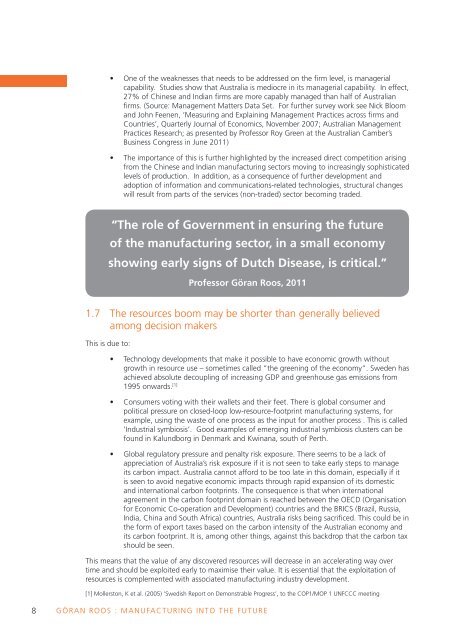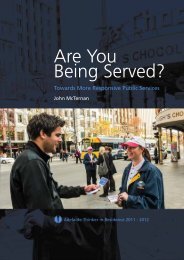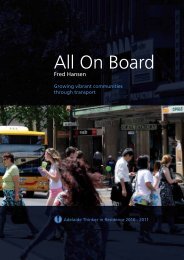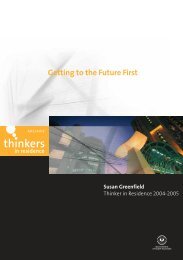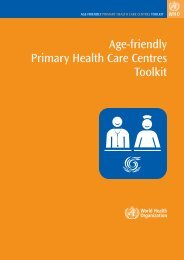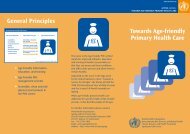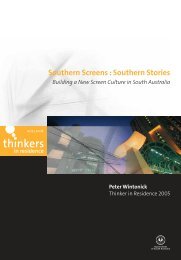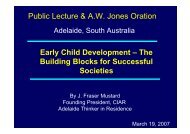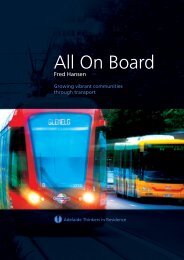Manufacturing into the future - Adelaide Thinkers in Residence - SA ...
Manufacturing into the future - Adelaide Thinkers in Residence - SA ...
Manufacturing into the future - Adelaide Thinkers in Residence - SA ...
- No tags were found...
Create successful ePaper yourself
Turn your PDF publications into a flip-book with our unique Google optimized e-Paper software.
• One of <strong>the</strong> weaknesses that needs to be addressed on <strong>the</strong> firm level, is managerialcapability. Studies show that Australia is mediocre <strong>in</strong> its managerial capability. In effect,27% of Ch<strong>in</strong>ese and Indian firms are more capably managed than half of Australianfirms. (Source: Management Matters Data Set. For fur<strong>the</strong>r survey work see Nick Bloomand John Feenen, ‘Measur<strong>in</strong>g and Expla<strong>in</strong><strong>in</strong>g Management Practices across firms andCountries’, Quarterly Journal of Economics, November 2007; Australian ManagementPractices Research; as presented by Professor Roy Green at <strong>the</strong> Australian Camber’sBus<strong>in</strong>ess Congress <strong>in</strong> June 2011)• The importance of this is fur<strong>the</strong>r highlighted by <strong>the</strong> <strong>in</strong>creased direct competition aris<strong>in</strong>gfrom <strong>the</strong> Ch<strong>in</strong>ese and Indian manufactur<strong>in</strong>g sectors mov<strong>in</strong>g to <strong>in</strong>creas<strong>in</strong>gly sophisticatedlevels of production. In addition, as a consequence of fur<strong>the</strong>r development andadoption of <strong>in</strong>formation and communications-related technologies, structural changeswill result from parts of <strong>the</strong> services (non-traded) sector becom<strong>in</strong>g traded.“The role of Government <strong>in</strong> ensur<strong>in</strong>g <strong>the</strong> <strong>future</strong>of <strong>the</strong> manufactur<strong>in</strong>g sector, <strong>in</strong> a small economyshow<strong>in</strong>g early signs of Dutch Disease, is critical.”Professor Göran Roos, 20111.7 The resources boom may be shorter than generally believedamong decision makersThis is due to:• Technology developments that make it possible to have economic growth withoutgrowth <strong>in</strong> resource use – sometimes called “<strong>the</strong> green<strong>in</strong>g of <strong>the</strong> economy”. Sweden hasachieved absolute decoupl<strong>in</strong>g of <strong>in</strong>creas<strong>in</strong>g GDP and greenhouse gas emissions from1995 onwards. [1]• Consumers vot<strong>in</strong>g with <strong>the</strong>ir wallets and <strong>the</strong>ir feet. There is global consumer andpolitical pressure on closed-loop low-resource-footpr<strong>in</strong>t manufactur<strong>in</strong>g systems, forexample, us<strong>in</strong>g <strong>the</strong> waste of one process as <strong>the</strong> <strong>in</strong>put for ano<strong>the</strong>r process . This is called‘Industrial symbiosis’. Good examples of emerg<strong>in</strong>g <strong>in</strong>dustrial symbiosis clusters can befound <strong>in</strong> Kalundborg <strong>in</strong> Denmark and Kw<strong>in</strong>ana, south of Perth.• Global regulatory pressure and penalty risk exposure. There seems to be a lack ofappreciation of Australia’s risk exposure if it is not seen to take early steps to manageits carbon impact. Australia cannot afford to be too late <strong>in</strong> this doma<strong>in</strong>, especially if itis seen to avoid negative economic impacts through rapid expansion of its domesticand <strong>in</strong>ternational carbon footpr<strong>in</strong>ts. The consequence is that when <strong>in</strong>ternationalagreement <strong>in</strong> <strong>the</strong> carbon footpr<strong>in</strong>t doma<strong>in</strong> is reached between <strong>the</strong> OECD (Organisationfor Economic Co-operation and Development) countries and <strong>the</strong> BRICS (Brazil, Russia,India, Ch<strong>in</strong>a and South Africa) countries, Australia risks be<strong>in</strong>g sacrificed. This could be <strong>in</strong><strong>the</strong> form of export taxes based on <strong>the</strong> carbon <strong>in</strong>tensity of <strong>the</strong> Australian economy andits carbon footpr<strong>in</strong>t. It is, among o<strong>the</strong>r th<strong>in</strong>gs, aga<strong>in</strong>st this backdrop that <strong>the</strong> carbon taxshould be seen.This means that <strong>the</strong> value of any discovered resources will decrease <strong>in</strong> an accelerat<strong>in</strong>g way overtime and should be exploited early to maximise <strong>the</strong>ir value. It is essential that <strong>the</strong> exploitation ofresources is complemented with associated manufactur<strong>in</strong>g <strong>in</strong>dustry development.[1] Mollerston, K et al. (2005) ‘Swedish Report on Demonstrable Progress’, to <strong>the</strong> COP1/MOP 1 UNFCCC meet<strong>in</strong>g8GÖRAN ROOS : MANUFACTURING INTO THE FUTURE


